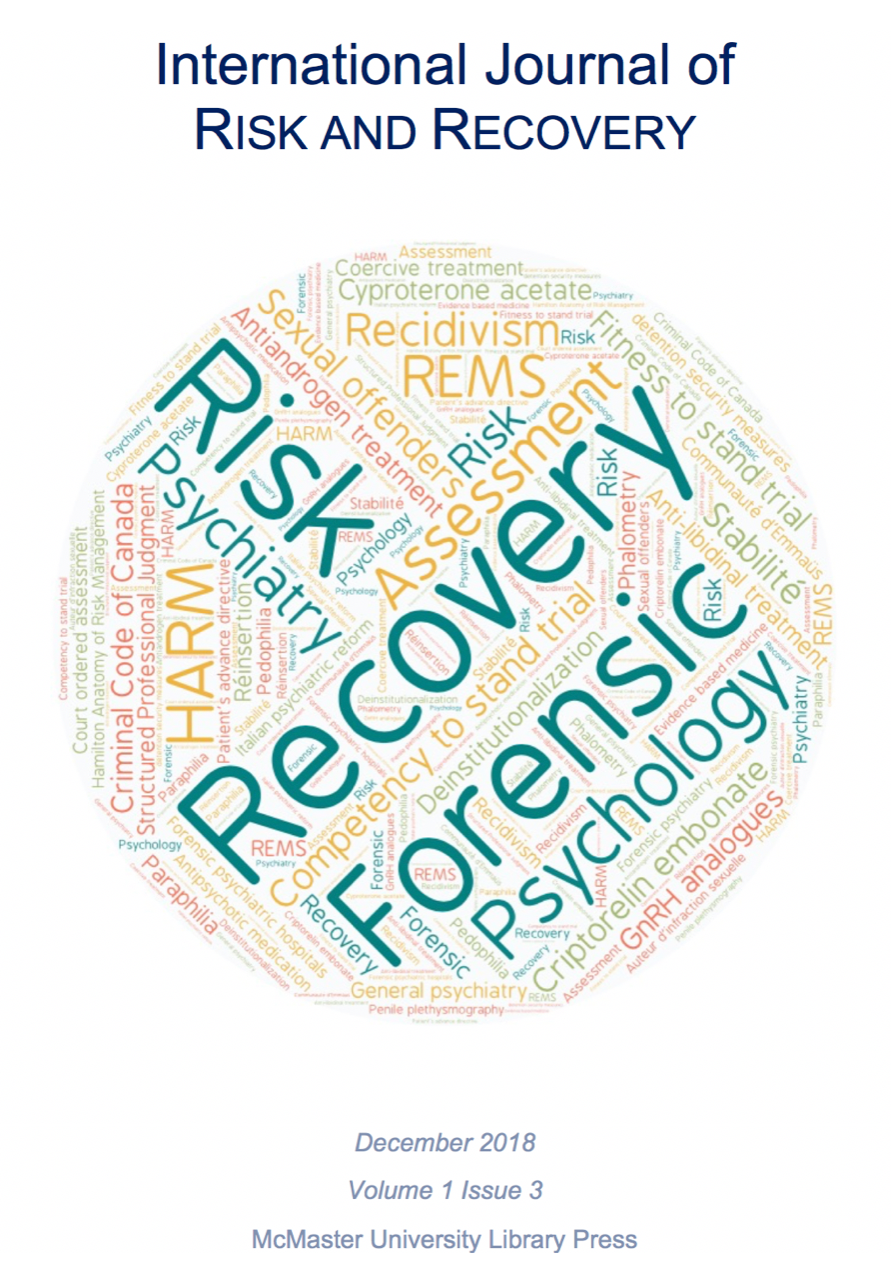Anti-libidinal medication among sex offenders
A descriptive study from a specialized outpatient unit in Bordeaux (France)
DOI:
https://doi.org/10.15173/ijrr.v1i3.3470Keywords:
Anti-libidinal treatment, Antiandrogen treatment, Sexual offenders, Cyproterone acetate, Criptorelin embonate, GnRH analogues, RecidivismAbstract
Enhancements in the treatment of sexual offenders has been taking place for over four decades. The development of pharmacological therapy has helped to reduce the risk of re-offense and has demonstrated its utility in combination with psychotherapy. However further studies to demonstrate the efficacy of these therapies are required. We conducted a retrospective study in a unit that provides care for sexual offenders (court ordered treatment or voluntary treatment). Among the 224 patients at ERIOS over the past 15 years, we identified 23 patients who had received anti-libidinal treatment (ALM) at some point in their care. The results, obtained from only 22 informative files, indicate that 16 patients presented no notion of deviant fantasy or behavioral relapse under medication. This study also highlights the comorbidities and offers a perspective regarding the improvement in prescribing this type of pharmacological therapy.
References
Cochez F, Guitz I, Lemoussu P. Le traitement judiciaire des auteurs d'infractions sexuelles. Actualités sociales hebdomadaires 2010.
Thibaut F, Barra FD, Gordon H, Cosyns P, Brad-ford JM, WFSBP Task Force on Sexual Disor-ders. The World Federation of Societies of Bio-logical Psychiatry (WFSBP) guidelines for the biological treatment of paraphilias. World J Biol Psychiatry 2010;11(4):604-55.
Cochez F, Cano JP, Bensilum I. Place des trai-tements médicaments dans la prise en charge des AVS. in Coutanceau R, Damiani C, La-cambre M (Eds). Victimes et auteurs de violences sexuelles. Paris, France: Dunod, 2016.
Haute Autorité de Santé. Prise en charge des auteurs d'agression sexuelle à l'encontre des mineurs de moins de 15 ans. Recommandations de bonne pratique 2009. (accessed on October 10, 2018).
Bradford JM, Pawlak A. Double-blind placebo crossover study of cyproterone acetate in the treatment of the paraphilias. Arch Sex Behav 1993;22(5):383–402.
Gagné P. Treatment of sex offenders with medroxyprogesterone acetate. Am J Psychiatry 1981;138(5):644–6.
Maletzky BM, Tolan A, McFarland B. The Oregon depo-Provera program: a five-year follow-up. Sex Abuse 2006;18(3):206–316.
Cooper AJ, Sandhu S, Losztyn S, Cernovsky Z. A double- blind placebo controlled trial of medroxyprogesterone acetate and cyproterone acetate with seven pedophiles. Can J Psychiatry 1992;37(10):687–93.
Loi n°2007-1198 du 10 août 2007 renforçant la lutte contre la récidive ders majeurs et des mi-neurs. JORF 11 août 2007. (accessed on October 10, 2018).
Harris AJR, Hanson RK (Eds). Sex offender re-cidivism: A simple question (Vol. 3). 2004, Otta-wa, Ontario: Public Safety and Emergency Pre-paredness Canada. (accessed on October 10, 2018).
Aldhous P. Debate over medicalisation of the urge to rape. New Scientist 2011;2813.
Downloads
Published
How to Cite
Issue
Section
License
Copyright Notice
Authors who publish with this journal agree to the following terms:
- Authors retain copyright of their work and grant the International Journal of Risk and Recovery the right of first publication with the work simultaneously licensed under a Creative Commons Attribution License. This allows others to share the work with an acknowledgement of the work’s authorship and initial publication in this journal.
- Authors are able to enter into separate, additional contractual arrangements for the non-exclusive distribution of the journal’s published version of the work (e.g., post it to an institutional repository or publish it in a book) with an acknowledgement of its initial publication in this journal.
- Authors are permitted and encouraged to post their work online (e.g., in institutional repositories or on their websites) before and during the submission process as it can lead to productive exchanges, as well as earlier and greater citation of published work. (See The Effect of Open Access.)

